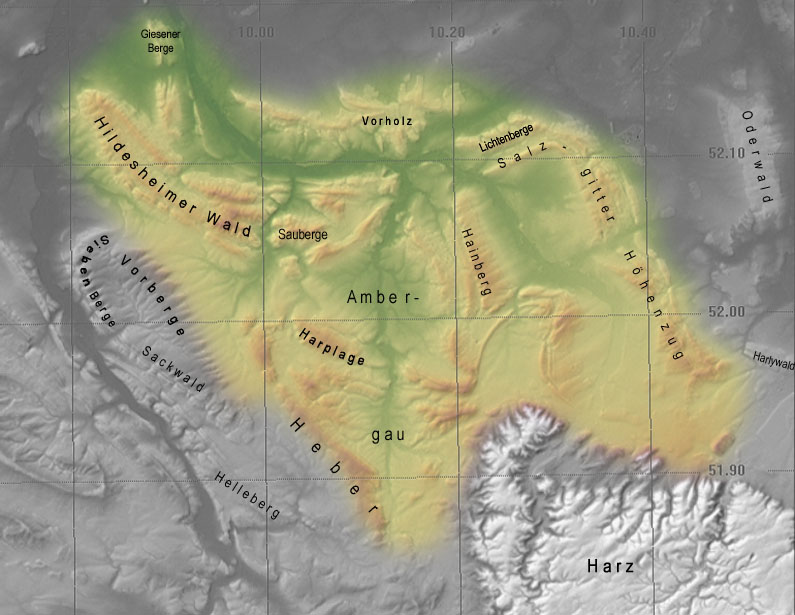|
Vorholz
The Vorholz is a ridge up to 243 m high in the districts of Landkreis Hildesheim, Hildesheim and Landkreis Wolfenbüttel, Wolfenbüttel in the German state of Lower Saxony. Geography The heavily-wooded Vorholz is located in the north of the Innerste Uplands, part of the Lower Saxon Hills. It lies north of the valley of the River Innerste between the ridges of Lichtenberge (northwestern section of the Salzgitter Hills) to the southeast, the Hainberg (hills), Hainberg to the south-southeast, the Sauberge to the south-southwest and the Hildesheim Forest to the west-southwest. It is also east-southeast of the city of Hildesheim and west of Salzgitter between Schellerten in the north, Burgdorf (bei Salzgitter), Burgdorf in the east-northeast and Holle in the south. Description The Vorholz attains its highest point on the summit of the Knebelberg, 243 m high, and is the source region for several tributaries of the Innerste (which touches it tangentially in the south) and t ... [...More Info...] [...Related Items...] OR: [Wikipedia] [Google] [Baidu] |
Sauberge
The Sauberge is a hill range up to in the Innerste Uplands in the district of Landkreis Hildesheim, Hildesheim in eastern Lower Saxony in Germany. Geography Location The wooded Sauberge is located in the centre of the northern part of the Innerste Uplands, a northeastern part of the Lower Saxon Hills, and borders on the historic Ambergau region. The hills extend east of the Hildesheim Forest, from Bad Salzdetfurth and the narrow valley of the Lamme to Derneburg. Hackenstedt is located in a broad valley east of the Bünte. A few kilometres east-northeast lies Holle and some distance away to the south-east is Bockenem; a few individual districts of these town boroughs reach as far as the ridge. One kilometre to the north a stretch of the Innerste river flows past the Sauberge in an east-west direction. To the east the Nette (Innerste), Nette runs past the hills from south to north. A few miles north-northeast is the ridge of Vorholz (ridge), Vorholz. Hills The hills of the S ... [...More Info...] [...Related Items...] OR: [Wikipedia] [Google] [Baidu] |
Innerste Uplands
The Innerste Uplands (german: Innerstebergland) is a landscape region up to 359 m high and covering an area of over 900 km² in the northern part of the German Central Uplands. It lies within the eastern part of the Weser-Leine Uplands in Lower Saxony (Germany). The Innerste Uplands gets its name from the Innerste, a tributary of the River Leine. Geography Location The Innerste Uplands cover the catchment area of the Innerste southeast of Hildesheim and southwest to south of Salzgitter as far as Goslar and Seesen on the northwestern edge of the Harz. To the north the area is bounded by the Hildesheim Börde, to the west by the Leine Uplands and to the southeast by the North Harz Foreland. Its central and southern areas are dominated by the Ambergau, a depression dissected by the Nette, a tributary of the Innerste. In and around the Innerste Uplands there are the following clearly defined ridges, most of which are cuestas and some of which lie on the boundary wit ... [...More Info...] [...Related Items...] OR: [Wikipedia] [Google] [Baidu] |
Hainberg (hills)
The Hainberg (known locally as the Hainberge as it has several summits. Also the old form Heinberg) is a hill range, up to 299 metres high, northwest of the Harz Mountains in the eastern part of Lower Saxony, Germany. Geography The heavily wooded Hainberg runs along the boundary of the counties of Wolfenbüttel, Goslar and Hildesheim. It is located in the centre of the im Zentrum des Innerste Uplands, a northeastern section of the Lower Saxon Hills, several kilometres southwest of the town of Salzgitter and borders on the Ambergau to the east. The ridge is west of the River Innerste, northwest of the Neile and east of the Nette between the ridges of Vorholz to the north-northwest and the Salzgitter Ridge (including the Lichtenbergen) to the north, northeast and east. South of the Hainberg are the northwestern fringes of the Harz Mountains. The Hainberg runs from Holle in the north-northwest and Baddeckenstedt to the north Norden and east to Lutter am Barenberge in the sout ... [...More Info...] [...Related Items...] OR: [Wikipedia] [Google] [Baidu] |
Lower Saxon Hills
The Lower Saxon Hills (german: Niedersächsisches Bergland) are one of the 73 natural regions in Germany defined by the Federal Agency for Nature Conservation (BfN). Geographically it covers roughly the same area as the Weser Uplands (german: Weserbergland) in its wider sense.However at least one source, Elkins (1968), uses the term to refer to the outcrops of rock to the north, west and southwest of the Harz which roughly corresponds to the eastern half of the BfN's region and extends only as far as the area between the rivers Weser and Leine. The region is part of Germany's Central Uplands with hills ranging up to in height that extend across northeast North Rhine-Westphalia, southern Lower Saxony and northern Hesse. It is classified as region number D 36 by the BfN; its full name being the ''Niedersächsisches Bergland (mit Weser- und Leine-Bergland'' (Lower Saxon Hills, including the Weser and Leine Hills). D 36 is a newly defined region that incorporates 3 geographical units f ... [...More Info...] [...Related Items...] OR: [Wikipedia] [Google] [Baidu] |
Hildesheim Forest
The Hildesheim Forest (german: Hildesheimer Wald) is a range of hills up to in the district of Hildesheim in the German state of Lower Saxony. Geography The Hildesheim Forest is located in the Innerste Uplands, part of the Lower Saxon Hills, between the valleys of the Leine to the west, the Innerste to the north and the Lamme to the east. These densely forested hills, which are bordered to the east by the Sauberge and lie a few kilometres west-southwest of the Vorholz, fill an area south of Hildesheim, northwest of Bad Salzdetfurth, north of Sibbesse and southeast of Nordstemmen. Description The Hildesheim Forest, which attain a height of 359 m in the Griesberg, are crossed by numerous waterways, hiking trails and forest tracks, but only by one state road, the L 485, which links Hildesheim via Diekholzen to Sibbesse. In its northwestern part is the Beusterburg, whose circular ramparts are suggestive of a New Stone Age settlement. In the vicinity of the vi ... [...More Info...] [...Related Items...] OR: [Wikipedia] [Google] [Baidu] |
Bundesautobahn 7
is the longest German Autobahn and the longest national motorway in Europe at 963 km (598 mi). It bisects the country almost evenly between east and west. In the north, it starts at the border with Denmark as an extension of the Danish part of European route E45, E45. In the south, the autobahn ends at the Austrian border. This final gap was closed in September 2009. Overview The Bundesautobahn 7 starts at Flensburg and travels through the two states at Schleswig and Rendsburg, through the world's busiest artificial waterway of Kiel Canal crossing the Rader high bridge. At Rendsburg you can change to the A 210, a feeder to the Schleswig-Holstein capital, Kiel. A few kilometers further south there is another feeder route to Kiel, the A 215, into the A7 at the interchange Bordesholm; however, this can only be reached from the south, likewise from the A 215 you can only reach the A7 in the south. South of Bordesholm, the highway has been continuously expanded to six lanes sinc ... [...More Info...] [...Related Items...] OR: [Wikipedia] [Google] [Baidu] |
Bundesstraße 6
The Bundesstraße 6 (abbr. B6) is a German federal highway running from Bremerhaven on the North Sea coast in a southeasterly direction through the states of Lower Saxony, Bremen, Saxony-Anhalt and Saxony to Görlitz on the Polish border. History East of Leipzig, the B6 (except of the ring roads around Meißen, Dresden and Bischofswerda) largely follows the historic course of the '' Via Regia Lusatiae Superioris'', part of the medieval ''Via Regia''. In 1937, the northwestern section of the former ''Reichsstraße 6'' (R6) was extended from Bremerhaven (Wesermünde) to Cuxhaven. Before World War II and the implementation of the Oder–Neisse line, the R6 road continued southeastwards from Görlitz via Hirschberg (present-day Jelenia Góra, Poland) and Schweidnitz (Świdnica) to the Silesian capital Breslau (Wrocław) and from there via Oels (Oleśnica) as far as the former Polish border near Groß Wartenberg (Syców). The sections between Görlitz/Zgorzelec and Syc ... [...More Info...] [...Related Items...] OR: [Wikipedia] [Google] [Baidu] |
Bundesstraße 444
''Bundesstraße'' (German for "federal highway"), abbreviated ''B'', is the denotation for German and Austrian national highways. Germany Germany's ''Bundesstraßen'' network has a total length of about 40,000 km. German ''Bundesstraßen'' are labelled with rectangular yellow signs with black numerals, as opposed to the white-on-blue markers of the ''Autobahn'' controlled-access highways. ''Bundesstraßen'', like autobahns, are maintained by the federal agency of the Transport Ministry. In the German highway system they rank below autobahns, but above the ''Landesstraßen'' and ''Kreisstraßen'' maintained by the federal states and the districts respectively. The numbering was implemented by law in 1932 and has overall been retained up to today, except for those roads located in the former eastern territories of Germany. One distinguishing characteristic between German ''Bundesstraßen'' and ''Autobahnen'' is that there usually is a general 100 km/h (62 mph) s ... [...More Info...] [...Related Items...] OR: [Wikipedia] [Google] [Baidu] |
Normalnull
("standard zero") or (short N. N. or NN ) is an outdated official vertical datum used in Germany. Elevations using this reference system were to be marked (“meters above standard zero”). has been replaced by (NHN). History In 1878 reference heights were taken from the Amsterdam Ordnance Datum and transferred to the New Berlin Observatory in order to define the . has been defined as a level going through an imaginary point 37.000 m below . When the New Berlin Observatory was demolished in 1912 the reference point was moved east to the village of Hoppegarten (now part of the town of Müncheberg, Brandenburg, Germany Germany,, officially the Federal Republic of Germany, is a country in Central Europe. It is the second most populous country in Europe after Russia, and the most populous member state of the European Union. Germany is situated betwe ...).S. German: ''Was ist "Normal-Null"?''. In: ''Physikalische Blätter'' 1958, vol 14, issue 2, p. ... [...More Info...] [...Related Items...] OR: [Wikipedia] [Google] [Baidu] |
Grasdorf (Holle)
Holle is a village and a municipality in the district of Hildesheim, in Lower Saxony, Germany. It is situated approximately 15 km southeast of Hildesheim, and 15 km west of Salzgitter. It was mentioned in Tom Clancy's bestseller ''Red Storm Rising ''Red Storm Rising'' is a war novel, written by Tom Clancy and co-written with Larry Bond, and released on August 7, 1986. Set in the mid-1980s, it features a Third World War between the North Atlantic Treaty Organization and Warsaw Pact for ...''. References External links Hildesheim (district) {{Hildesheim-geo-stub ... [...More Info...] [...Related Items...] OR: [Wikipedia] [Google] [Baidu] |




